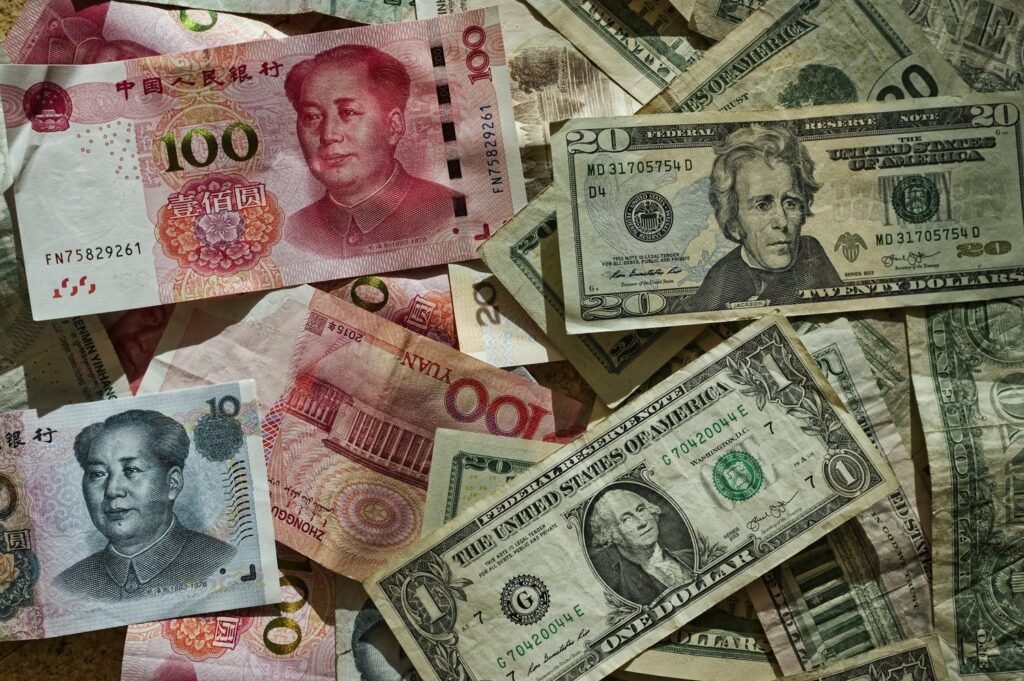After World War II, with its unquestioned global leadership in industrial production and finance, the United States negotiated an arrangement at the Bretton Woods Conference that would make the dollar central to global trade and finance.
But the global economy has changed profoundly since World War II. The US accounted for roughly half of global GDP in 1945 — today it accounts for around 25 per cent. Yet the US dollar’s share of global international reserves has only slightly declined, and the dollar remains by far the leading international currency. By definition, an international currency is used and held outside of its issuing jurisdiction and not necessarily for transactions involving the issuing country.
However, whereas the dollar’s ups and downs in the past 50 years have mostly been relative to the currencies of friendly or allied economies, the dollar’s most recent competitor now comes from the United States’ strategic rival — China. The momentum of China’s renminbi has larger geopolitical implications, including the potential for evading US sanctions.
How US sanctions work
Much of the United States’ sanctions power depends on the dollar’s centrality in the international financial system. Around 96 per cent of global dollar-denominated transactions ultimately pass through a network of banks participating in the US-based Clearing House Interbank Payment System (CHIPS), which settles transactions in conjunction with another US-based network, FedWire. As these networks are subject to US law, the United States can cut foreign institutions out of the “dollar network”. And since much of global trade is settled in dollars, the damage to countries’ economies can be significant.
In the end, the path to widespread use of the renminbi — at least to trade with China — is US sanctions themselves.
The United States has a secondary sanctions power: its ability to, if necessary, compel Belgium-domiciled Society for Worldwide Interbank Financial Telecommunications (SWIFT) to cut banks off from its messaging network. Doing so isn’t necessarily as crippling as losing access to the dollar network, but it substantially increases transaction costs for banks.
As US reliance on financial sanctions has grown over time, many countries have concluded that exposure to the dollar means US sanctions exposure. If US adversaries and their economic partners were to use an alternative currency to the dollar for international transactions and develop an alternative to the SWIFT messaging system for their cross-border business, they could build resiliency against US sanctions and reduce the potency of US economic statecraft.
The rise and limits of China’s renminbi
The renminbi has internationalised over the past 15 years as China’s economy has grown to be the second largest in output and first in international trade. But size isn’t sufficient, as Beijing has pursued currency internationalisation through a range of measures such as capital account liberalisation and renminbi swap lines with foreign central banks.
In May 2024, the renminbi was used in 3.12 per cent of global SWIFT payments, up from 1.27 per cent in September 2020 (both values exclude payments within the Eurozone). In 2015, Beijing launched the Cross-Border Interbank Payment System (CIPS) to serve as a renminbi-based cross-border payment and settlement platform. Despite the renminbi’s momentum, several economic and political constraints limit the currency’s full internationalisation.
First, China still controls the inflow and outflow of the renminbi despite incremental liberalisation. These capital controls help Beijing manage the renminbi’s exchange rate and prevent capital flight, but they make it harder and less convenient for international investors to hold and trade China’s currency. Moreover, if the renminbi were to become the primary international currency, China would probably have to tolerate current account deficits to allow foreign entities to accumulate renminbi balances and assets, something that Beijing would be loath to do.
Second, the renminbi’s volumes in global trade and finance remain negligible, which limits network effects. While the renminbi’s presence in SWIFT payments and central banks’ reserve currencies has risen, its share of global reserves and export invoicing currently hovers around 2 and 4 per cent respectively, far below the US dollar’s share of 58 per cent of reserves and 54 per cent of export invoicing. Moreover, CHIPS can process 40 times as many transactions and 10 times as many banks compared to CIPS. Reaching critical volumes in these domains is key for a currency’s ability to leverage network effects, namely the self-reinforcing cycle whereby the more a currency is used, the more likely it will be adopted. Network effects are essential for full currency internationalisation virtually by definition. And even if major global economic players adopted the renminbi, China currently does not offer assets that are nearly as liquid (and currently, high-yielding) as US Treasuries in which countries could effectively park their trade surpluses.
Third, CIPS remains dependent on SWIFT, meaning that China is not insulated from SWIFT-related sanctions. Several years ago, reportedly 80 per cent of CIPS transactions used SWIFT’s messaging systems as banks still lack CIPS-specific tools. Data on the CIPS internal messaging system is scarce but can be assumed that only direct participants (typically Chinese banks) in the CIPS network use it.
Risks to US sanctions: Short-term
In the short term, Western sanctions on Russia have resulted in increased China-Russia trade and thus encouraged greater renminbi use to avoid sanctions. China’s trade settlement in renminbi, however, has increased far more than can be explained by trade with Russia, suggesting that some economies — probably in Asia — are using the renminbi to reduce sanctions exposure or to take advantage of comparatively low trade finance costs in renminbi.
Going forward, the renminbi could become the currency that entities under US sanctions and those hedging against future US sanctions resort to when diversifying their trade away from US-centric channels, especially if a greater number of bilateral swap lines are created between central banks. Similarly, it could also feature more prominently in foreign central banks’ basket of reserve currencies, especially if and when US interest rates decline.
However, the renminbi’s role in de-dollarisation efforts would still be limited to trade or investment with China and hard to scale, mostly because of China’s capital controls and the limited supply of offshore renminbi assets. China’s swap lines might help, but thus far evidence suggests they’re used more for financial and macroeconomic support for distressed economies like Argentina and Pakistan than for trade facilitation. In short, it is hard to imagine entities outside of China (and outside of Russia’s bilateral trade relations), say when Venezuela trades with Brazil, to settle a critical amount of their trade in renminbi to bypass US sanctions. And yet, this is crucial for the renminbi to increase volumes, reach network effects, and fully internationalise.
Another key problem is that major Chinese banks — the direct participants in CIPS — are themselves dependent on the US network for international finance. Even if renminbi use increased, a large share of their international exposure would remain in dollars and therefore vulnerable to US sanctions.
Risks to US sanctions: Long-term
In the long term, the digital renminbi’s development could help speed up its internationalisation process if it can disintermediate the US dollar for liquid (low cast) currency cross pairs. Experimentation to do so is underway, at least implicitly, with the mBridge program, but it remains in the early stages. It also remains to be seen that such cross-border wholesale use of the digital renminbi, even if technically feasible at scale, would be cheaper than using the dollar. And the digital renminbi would essentially replace today’s bank reserve and cash for wholesale purposes but by design wouldn’t pay interest, limiting its attractiveness as a reserve asset. China can lobby Global South nations to use the renminbi, but ultimately whether their banks do so will be determined by market factors.
In the end, the path to widespread use of the renminbi — at least to trade with China — is US sanctions themselves. Because of network effects and switching costs, the US dollar (its network and SWIFT) is set to remain more attractive, unless US sanctions compel China’s counterparties to move away from the dollar. This could happen incrementally if the United States were to impose sanctions on other countries, but the most plausible scenario would be the imposition of a massive sanctions regime on China itself. Realistically, this is only imaginable to occur in the event of a US-China conflict.
Indeed, Chinese leaders are concerned about their country’s resilience vis-à-vis US sanctions, whose implementation against China would nonetheless be highly consequential for the US and global economy given the size and interconnectedness of the US and Chinese markets. That’s reason to think that Washington would be reluctant to use them, which Beijing likely understands. And it’s also reason to think that the US dollar will remain dominant and US sanctions power will remain largely intact, at least in the short term. But it might be a hand the US government can only play once.
DISCLAIMER: All views expressed are those of the writer and do not necessarily represent that of the 9DASHLINE.com platform.
Author biography
Andrea Leonard Palazzi is a research associate with the Geoeconomic Council of Advisers at the Center for Strategic and International Studies (CSIS). His research focuses on US-China economic competition and interdependence, sanctions, monetary and industrial policy, and currencies. Prior to joining CSIS, he was a graduate research fellow at the South African Reserve Bank in Pretoria, where he worked on monetary policy in the economic research department. Palazzi received his MA in European public policy from the Johns Hopkins School of Advanced International Studies and his BA, magna cum laude, in international affairs with a minor in legal studies from John Cabot University. He has studied and worked in Europe and Africa and speaks fluent Italian and conversational French and Spanish. The author wishes to thank Gerard DiPippo, Senior Geo-Economics Analyst at Bloomberg Economics, for his helpful feedback. Image credit: Eric Prouzet/Unsplash.







